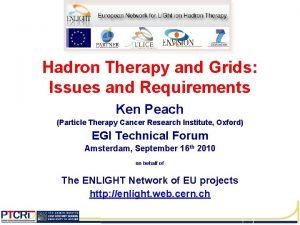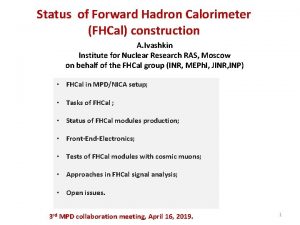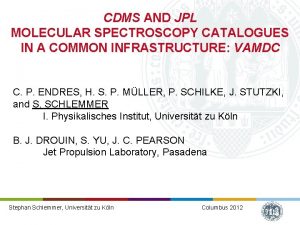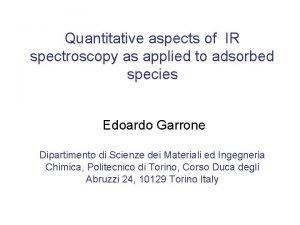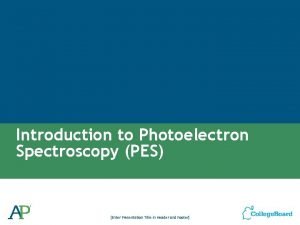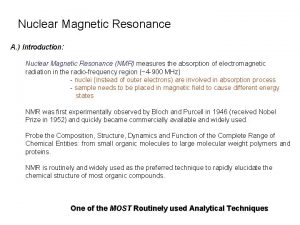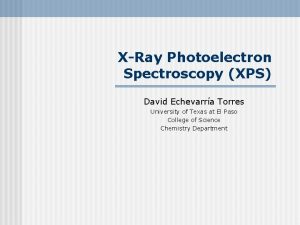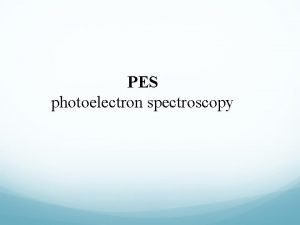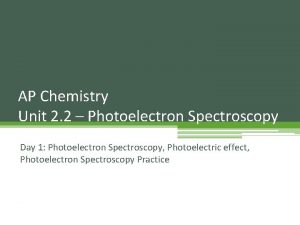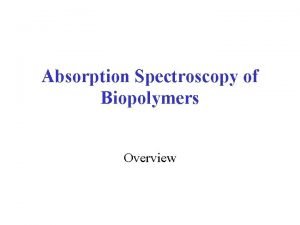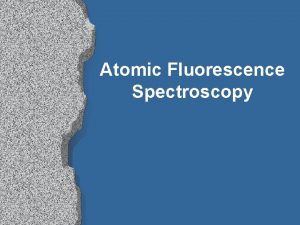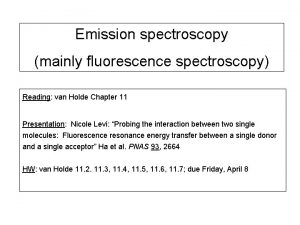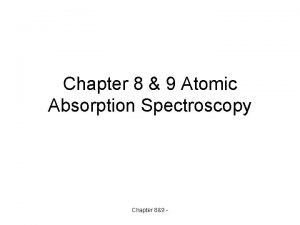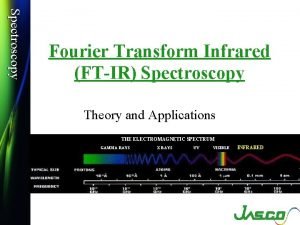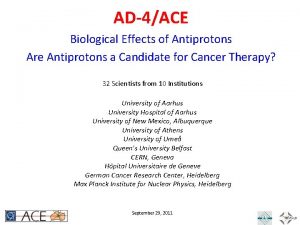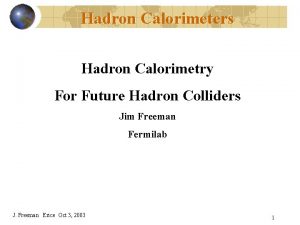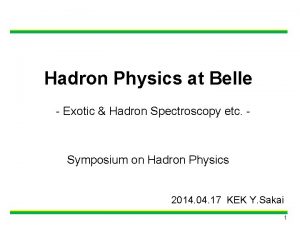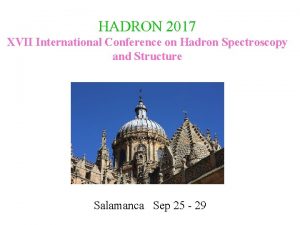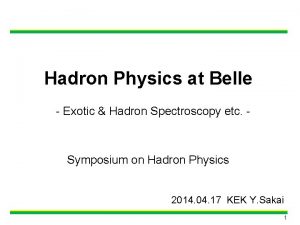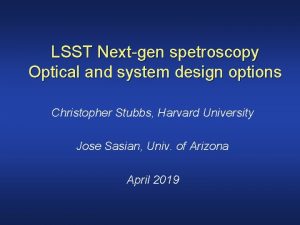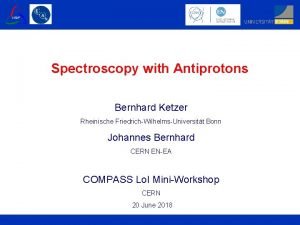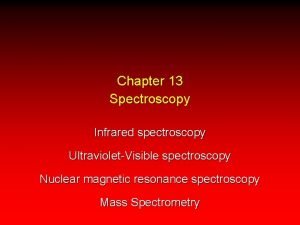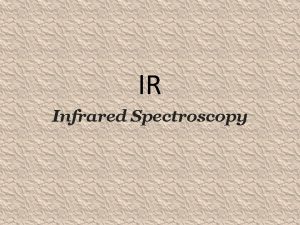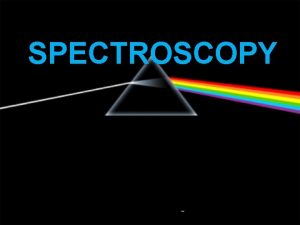Hadron Spectroscopy with Antiprotons Historical Overview Spetroscopy with


















- Slides: 18

Hadron Spectroscopy with Antiprotons Historical Overview Spetroscopy with antiproton beams Conventional beams LEAR-era (Fixed p-energy) Fermilab/ISR-experiments (p scan) Future Project PANDA @ FAIR/GSI Conclusions H. Koch; Seminar Graduate College Bochum/Dortmund; 21. 12. 05

Historical Overview (1) Detection of Antiprotons/Antineutrons 1955: Bevalac (p @ 6. 2 Ge. V), Cu- target Conventional p-beams 1956 -1981: BNL, Argonne CERN, Serpukhov, KEK, . . . π–/p ≈ 50000 Cooling of Antiprotons (1981/2) ICE, AA-rings @ CERN Acceleration/Deceleration/Storage of antiprotons; Pure antiproton beams H. Koch; Seminar Graduate College Bochum/Dortmund; 21. 12. 05

Historical Overview (2) SPSC/LEAR @ CERN 1981 -1996 LEAR Fermilab (Antiproton Source) / ISR @ CERN 1986 -2002 1981/83 AD @ CERN 2001 -today Only low energy antiprotons; Pulsed beam (low d. c. ) H. Koch; Seminar Graduate College Bochum/Dortmund; 21. 12. 05

Spectroscopy with Antiproton Beams (1) I) Conventional Beams Typical example: Bevalac: π–/p ≈ 50000 In general: Large contaminations (π–, K–, . . . ) Ill defined energy Particle separators Discovery of new mesons: (782), f 1(1285), E/ (1440) Many properties (masses, q. -n. , magn. mom. , BR‘s) of already known mesons Detectors: BC, Electronic detectors H. Koch; Seminar Graduate College Bochum/Dortmund; 21. 12. 05

Spectroscopy with Antiproton Beams (2) II) LEAR era Typical reactions Small beam spot Small p/p Experiments with stopped antiprotons Initial states = pp-atom states Experiments with p‘s in flight Initial states = scattering states More initial states More involved PWA (Tricks: Measure near threshold) No limitation of M(resonances) Few initial states (3 S 1, 1 S 0, P-States) Facilitates PWA Population of states dependent on H 2 -gas pressure (Day, Snow, Sucher) Limitation: M(resonances) ≤ 1. 6 Ge. V H. Koch; Seminar Graduate College Bochum/Dortmund; 21. 12. 05

Spectroscopy with Antiproton Beams (3) Situation in light quark spectroscopy H. Koch; Seminar Graduate College Bochum/Dortmund; 21. 12. 05

Spectroscopy with Antiproton Beams (4) Crystal Barrel Detector (CB) Obelix Detector (OX) General remark: Nearly all known resonances clearly seen in data Selected results: Dalitz plot of p. Stopp 3π0 (CB) 712000 events f 0(1500) firstly seen, Glueball ground state? H. Koch; Seminar Graduate College Bochum/Dortmund; 21. 12. 05

Spectroscopy with Antiproton Beams (5) Dalitz plot of p. Stopn π0 π– (CB) 52000 events Clear confirmation of spin exotic state (JPC = 1 -+!) Not allowed for qq-systems Dalitz plot and invariant mass spectrum of p. Stopp π+π–K 0 K±π (OX) ± Clear confirmation of E/i(1440) Glueball state? H. Koch; Seminar Graduate College Bochum/Dortmund; 21. 12. 05

Spectroscopy with Antiproton Beams (6) Discussion of the JPC = 0++ nonet Nine open slots, but twelve candidates Possible scenario: a 0(980), f 0(980) : 4 quark states H. Koch; Seminar Graduate College Bochum/Dortmund; 21. 12. 05

Spectroscopy with Antiproton Beams (7) Direct production of all cc-states: pp (cc) e+e–, , hadrons (e+e–: only JPC = 1 --cc-states) High mass resolution: Only determined by energy spread of p-beam, not by detection of decay particles Mass resolution ≈ 240 ke. V First survey experiments: R 704 (ISR); E 760/835 (Fermilab) (No 4π-detector; only parasitic running) H. Koch; Seminar Graduate College Bochum/Dortmund; 21. 12. 05

Spectroscopy with Antiproton Beams (8) Selected results c-mass and width c 1 -signals in Crystal Ball (e+e–) and E 835 (pp) H. Koch; Seminar Graduate College Bochum/Dortmund; 21. 12. 05

Future Perspectives (1) FAIR-Project at GSI Primary Beams • 1012/s; 1. 5 Ge. V/u; 238 U 28+ • 1010/s 238 U 73+ up to 35 Ge. V/u • 3 x 1013/s 30 Ge. V protons Secondary Beams • Broad range of radioactive beams up to 1. 5 - 2 Ge. V/u; up to factor 10 000 in intensity over present • Antiprotons 3 (0) - 30 Ge. V Storage and Cooler Rings • Radioactive beams • 1011 stored and cooled 1 - 15 Ge. V/c antiprotons H. Koch; Seminar Graduate College Bochum/Dortmund; 21. 12. 05

Future Perspectives (2) Antiprotons at FAIR HESR: General Purpose Detector: PANDA Formation: p(scan)p X . . . Production: p(fixed )p X + nπ +. . . PANDA-Collaboration: 370 scientists from 8 countries and 30 institutions H. Koch; Seminar Graduate College Bochum/Dortmund; 21. 12. 05

Future Perspectives (3) QCD systems to be studied with PANDA Rates H. Koch; Seminar Graduate College Bochum/Dortmund; 21. 12. 05

Future Perspectives (4) Physics Program Charmonium Search for new states above DD-threshold Precision determination of masses and widths (Extremly high masses resolution 20 ke. V) Production cross sections Decay branching ratios Exotica Glueballs, Charmed Hybrids, Multiquark states Predictions for Glueballs Prediction for Charmed Hybrids Lowest energy states: 3. 9 - 4. 5 Ge. V Ground state: JPC = 1–+ (Spin exotic!) Widths: Could by narrow in some cases (≈ Me. V) H. Koch; Seminar Graduate College Bochum/Dortmund; 21. 12. 05

Future Perspectives (5) Open Charm Physics Widths of states e. g. : pp Ds. J* (2317) D*s. J(2317) H. Koch; Seminar Graduate College Bochum/Dortmund; 21. 12. 05

Future Perspectives (6) Hadrons in matter Hypernuclear Physics p(3 Ge. V/c)p – (slow) – (fast) – p (inside nucleus) Further Options Baryon Spectroscopy CP-Violation in D-decays Deeply Virtual Compton Scattering (DVCS) Proton FF in time-like region Not discussed: Low energy p-physics: H, Antiprotonic Atoms, p 4 He H. Koch; Seminar Graduate College Bochum/Dortmund; 21. 12. 05

Conclusions/Merits of Antiprotons for Spectroscopy All qq-states can be formed directly (not only 1 --) High mass resolution for all states pp cross sections high Data with high statistics High probability for production of exotic states Example: 1 -+-state in pp-annihilation (LEAR) Low final state multiplicities Allows complete PWA H. Koch; Seminar Graduate College Bochum/Dortmund; 21. 12. 05
 Hadron
Hadron Hadron collider
Hadron collider Hadron collider
Hadron collider Hadron
Hadron Hadron calorimeter
Hadron calorimeter Upcdms
Upcdms Ir spectroscopy
Ir spectroscopy Pes spectrum for magnesium
Pes spectrum for magnesium Nmr spectroscopy
Nmr spectroscopy Xps instrument
Xps instrument Beryllium pes spectrum
Beryllium pes spectrum Uv vis spectroscopy in pharmaceutical analysis
Uv vis spectroscopy in pharmaceutical analysis Photoelectron spectroscopy ap chemistry
Photoelectron spectroscopy ap chemistry Isobestic points
Isobestic points Slit spectroscopy
Slit spectroscopy Atomic fluorescence spectroscopy principle
Atomic fluorescence spectroscopy principle Application of fluorescence spectroscopy
Application of fluorescence spectroscopy Total consumption burner
Total consumption burner Spectroscopy definition
Spectroscopy definition
